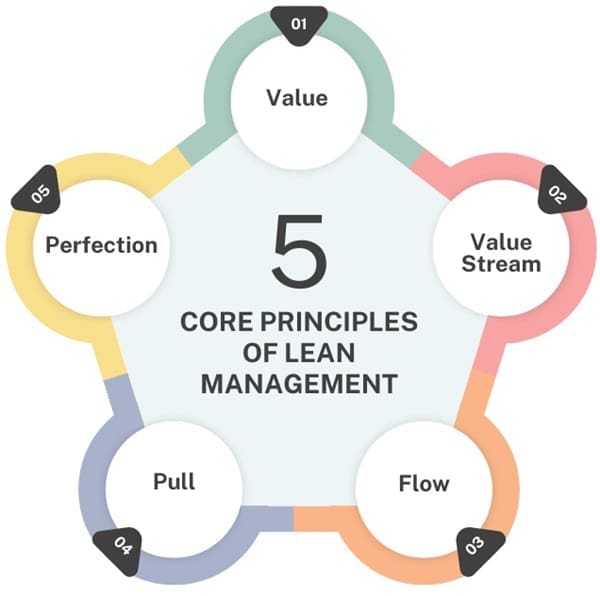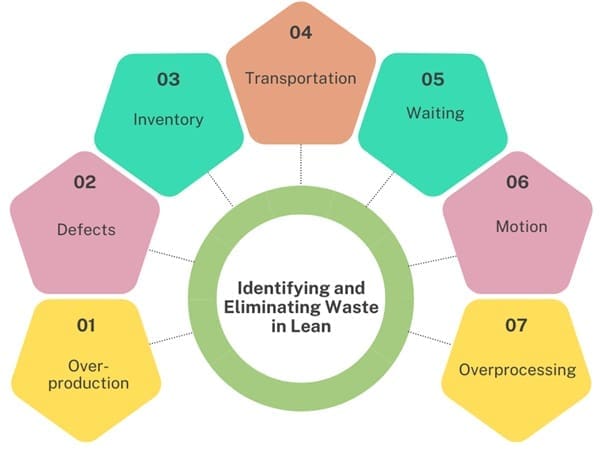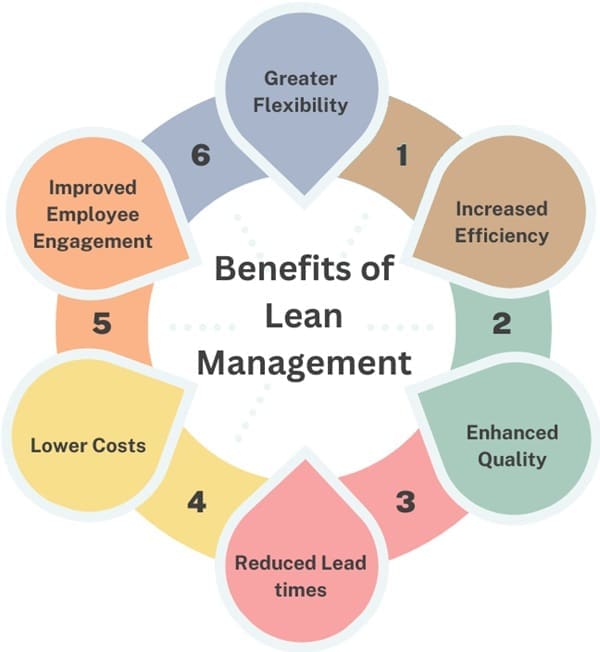Lean management is a transformative approach to business operations that focuses on maximizing value while minimizing waste. Originating from the Toyota Production System (TPS), lean management has evolved into a universally applicable methodology that extends beyond manufacturing into various sectors, including healthcare, services, and administration.
This comprehensive guide explores lean management principles, practices, and benefits in detail, offering insights into how organizations can adopt and implement lean practices to drive efficiency and enhance value.
Lean Management is a business philosophy and methodology aimed at improving efficiency and quality by systematically reducing waste and optimizing processes. Its principles, tools, and techniques are grounded in the pursuit of continuous improvement, which can be applied across various industries beyond manufacturing.
This comprehensive guide explores the fundamentals of Lean Management, its differences from other methodologies like Kaizen and Six Sigma, and its core principles and tools.
Table of contents
What is Lean Management?
Lean management systematically improves process efficiency and effectiveness by eliminating waste and optimizing value.
The term “lean” refers to the concept of lean muscle—muscle that is free from excess fat. Similarly, lean management seeks to remove unnecessary elements, or “waste,” from processes to create a more streamlined and effective system. This approach embraces the philosophy of continuous improvement and focuses on delivering greater value to customers while using fewer resources.
Historical Background
The concept of lean management was popularized by Jim Womack, Daniel Jones, and Daniel Roos in their seminal book, The Machine That Changed the World (1991). The authors analyzed the Toyota Production System, which revolutionized manufacturing by focusing on waste reduction and continuous improvement.
Toyota applied the principles of lean management, and organizations worldwide have since adapted and adopted these principles to enhance their operational efficiency and competitiveness.
Core Principles of Lean Management

Lean management is based on several core principles that guide organizations in their pursuit of operational excellence:
- Value
Value is the foundation of lean management. Value is defined from the customer’s perspective as the attributes of a product or service that they are willing to pay for. In lean terms, customers spend their money on value, which comes from activities that transform inputs into outputs that satisfy their needs. Understanding and defining value is crucial for identifying and eliminating waste.
- Value Stream
The value stream encompasses all the activities and processes involved in delivering a product or service to the customer. Value stream mapping is a technique used to visualize and analyze the flow of materials and information through the production process.
By mapping the value stream, organizations can identify areas where waste occurs and opportunities for improvement. The goal is to optimize the value stream to ensure that every step adds value and contributes to the overall efficiency of the process.
- Flow
Flow refers to the seamless and uninterrupted movement of products or services through the production process. Achieving an optimal flow involves removing bottlenecks, delays, and interruptions that impede the efficient progression of work.
Lean management emphasizes creating a continuous flow where each step follows logically from the previous one, reducing cycle times and enhancing overall productivity.
- Pull
The pull principle involves producing goods or services based on actual customer demand rather than forecasts or predictions. In a pull system, customer orders or signals trigger production, which keeps inventory levels to a minimum and reduces the risk of overproduction.
This approach aligns production with real demand, leading to more efficient resource utilization and reduced waste.
- Perfection
Lean management is a continuous journey towards perfection. Once the value is defined, waste is removed, and flow and pull systems are established, the process is revisited to seek further improvements.
The pursuit of perfection involves ongoing efforts to enhance processes, eliminate remaining waste, and continually refine operations. This iterative approach ensures that organizations remain agile and responsive to changing market conditions.
Identifying and Eliminating Waste

In lean management, waste, or “muda,” is defined as anything that does not add value to the customer. The goal is to identify and eliminate waste to improve efficiency and effectiveness. The seven traditional types of waste, as identified by the Toyota Production System, include:
- Over-production
Over-production occurs when more goods are produced than needed or produced too early. This type of waste leads to excess inventory, increased storage costs, and the risk of obsolescence. It also ties up resources and space that could be used more effectively.
Defects refer to errors or imperfections in products or services that require rework or result in scrap. This waste not only increases costs but also affects customer satisfaction and can lead to additional quality control efforts.
- Inventory
Excess inventory includes raw materials, work-in-progress, and finished products that are not immediately required. High inventory levels lead to increased storage costs, higher financing costs, and potential quality issues.
- Transportation
Transportation waste involves unnecessary movement of materials between different stages of production. This waste does not add value and can increase cycle times, labor costs, and the risk of damage to materials.
Waiting waste occurs when workers or machines are idle due to delays or bottlenecks in the production process. This waste increases labor costs and reduces overall productivity.
Motion waste includes unnecessary physical movements by workers, such as walking or reaching for tools. Inefficient motion can slow down the production process and lead to ergonomic issues.
Over-processing refers to performing more work than is necessary to meet customer requirements. This waste includes excessive polishing or finishing that does not add value from the customer’s perspective.
Types of Waste Beyond the Traditional Seven
In addition to the traditional seven types of waste, lean practitioners also address:
Mura (Irregularity
Mura refers to variability or unevenness in processes. Irregular occurrences or fluctuations can lead to inefficiencies and affect overall performance. Lean management seeks to address and reduce mura by standardizing processes and reducing variability.
Muri (Overburden
Muri involves placing excessive stress or demands on workers or processes. This can lead to strain, errors, and inefficiencies. Lean management aims to reduce muri by optimizing workloads and improving ergonomics.
Muda (Waste): Muda refers to any activity or resource expenditure that does not add value to the final product. In lean management, waste is categorized into several types:
- Excess Production: Producing more than needed, which can lead to obsolescence and excess inventory.
- Delays: Waiting times for materials or information that hinder productivity and extend lead times.
- Movement and Transport: Unnecessary movement of materials or personnel, which adds no value and can result in damage or inefficiency.
- Poor Process Design: Inefficient processes that overuse resources or create bottlenecks.
- Inventory: Excess inventory ties up capital and space, and can lead to waste if products become obsolete.
- Inefficient Performance: Processes that are not optimized, leading to unnecessary effort and cost.
- Defective Items: Poor quality products that require rework or result in scrap.
Value Stream Mapping
Value stream mapping is a powerful tool used to visualize and analyze the flow of materials and information through the production process. It helps organizations identify value-added and non-value-added activities, providing insights into areas for improvement. The process involves:
Mapping the Current Stat
Create a visual representation of the current state of the value stream, including all steps and processes involved. This map should reflect actual practices rather than idealized scenarios.
Identifying Waste
Analyze the current state map to identify areas of waste, including overproduction, defects, excess inventory, and other inefficiencies.
Designing the Future State
Develop a future state map that eliminates identified waste and improves flow. The goal is to create a streamlined process with minimal non-value-added activities.
Implementing Improvements
Implement changes based on the future state map, focusing on reducing waste and enhancing efficiency. Monitor progress and adjust as needed to achieve the desired outcomes.
Lean Tools and Techniques

It employs various tools and techniques to support waste reduction and continuous improvement. Some of the key tools include:
5S is a methodology for organizing and standardizing the workplace. The five stages—Sort, Set in Order, Shine, Standardize, and Sustain—help create a clean, organized, and efficient work environment.
Kaizen
Kaizen, meaning “continuous improvement,” involves making small, incremental changes to improve processes and address inefficiencies. It emphasizes employee involvement and fosters a culture of ongoing improvement.
Kanban
Kanban is a visual information system that manages inventory and production flow. It uses cards or signals to show when new production or inventory is needed, enabling a pull-based system.
Just-In-Time (JIT)
JIT is a production strategy that aims to produce goods only as they are needed, minimizing inventory levels and reducing waste. This approach relies on accurate demand forecasting and efficient production processes.
Value Stream Mapping (VSM)
As previously mentioned, VSM is used to visualize and analyze the flow of materials and information through a production process. It helps identify waste and areas for improvement.
Root Cause Analysis
Root cause analysis involves identifying the underlying causes of problems or inefficiencies. Techniques such as the “5 Whys” and fishbone diagrams are used to uncover the root causes and develop effective solutions.
Implementing Lean Management

Successfully implementing lean management requires a strategic approach and commitment from all levels of the organization. Key steps include:
- Leadership Commitment: Effective implementation of lean management requires strong support from leadership. Leaders must commit to the principles of lean and actively promote a culture of continuous improvement.
- Employee Involvement: Engaging employees in lean initiatives is crucial for success. Employees should be trained in lean principles and encouraged to contribute ideas for improvement. Their involvement helps drive change and fosters a culture of collaboration.
- Training and Education: Providing training and education on lean principles and tools is essential for successful implementation. Equip employees at all levels with the knowledge and skills necessary to apply lean practices effectively.
- Continuous Improvement: Lean management is an ongoing process of continuous improvement. Organizations should regularly review and assess their processes, identify areas for improvement, and implement changes to enhance efficiency and value.
- Measurement and Monitoring: Establishing metrics and monitoring performance is essential for evaluating the effectiveness of lean initiatives. Key performance indicators (KPIs) should be used to track progress and identify areas for further improvement.
Benefits of Lean Management

Adopting lean management can lead to a range of benefits for organizations, including:
- Increased Efficiency
By eliminating waste and optimizing processes, lean management helps organizations operate more efficiently. This leads to faster production times, reduced costs, and improved resource utilization.
- Enhanced Quality
Lean practices focus on continuous improvement and defect reduction, leading to higher-quality products and services. Improved quality enhances customer satisfaction and reduces costs associated with rework and returns.
- Reduced Lead Times
Lean management aims to streamline processes and improve flow, resulting in reduced lead times and faster delivery of products and services. This enables organizations to respond more quickly to customer demands and market changes.
- Lower Costs
By minimizing waste and optimizing resource utilization, lean management helps organizations reduce costs. Lower production costs and improved efficiency contribute to increased profitability.
- Improved Employee Engagement
Lean management fosters a culture of continuous improvement and employee involvement. Engaged employees are more likely to contribute ideas, collaborate, and take ownership of their work, leading to higher job satisfaction and productivity.
- Greater Flexibility
Lean practices enhance organizational agility by creating more responsive and adaptable processes. This enables organizations to quickly adjust to changes in customer demand, market conditions, and other external factors.
Case Studies
Several organizations have successfully implemented lean management to achieve significant improvements. Here are a few notable examples:
Toyota
Toyota is widely recognized for its implementation of lean management through the Toyota Production System. By focusing on waste reduction, continuous improvement, and employee involvement, Toyota has achieved remarkable success in manufacturing efficiency and quality.
Lean Healthcare
Healthcare settings have successfully applied Lean principles to improve patient care and operational efficiency. For example, Virginia Mason Medical Center in Seattle implemented lean practices to streamline processes, reduce wait times, and enhance patient outcomes.
The Home Depot
The Home Depot adopted lean management to improve its supply chain and inventory management. By implementing lean principles, the company was able to reduce lead times, lower costs, and enhance customer satisfaction.
Challenges and Considerations

Implementing lean management can present challenges, including:
- Resistance to Change: Employees and managers may resist changes associated with lean initiatives. Overcoming resistance requires effective communication, training, and involvement of all stakeholders.
- Sustaining Improvements: Maintaining lean improvements over time can be challenging. Organizations must commit to continuous improvement and regularly review and refine processes to sustain the benefits of lean management.
- Resource Allocation: Implementing lean management requires investment in training, tools, and resources. Organizations should allocate adequate resources to support lean initiatives and ensure successful implementation.
Final Words
Lean management is a powerful methodology that helps organizations enhance efficiency, reduce waste, and deliver greater value to customers. By focusing on core principles such as value, waste reduction, flow, pull, and perfection, organizations can achieve significant improvements in productivity, quality, and customer satisfaction.
The successful implementation of lean management requires leadership commitment, employee involvement, and a commitment to continuous improvement. As organizations embrace lean practices, they can drive operational excellence and remain competitive in an ever-changing business landscape.




















